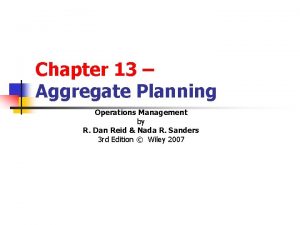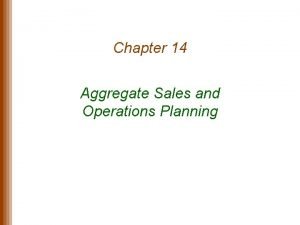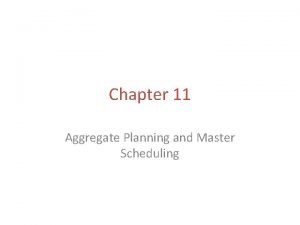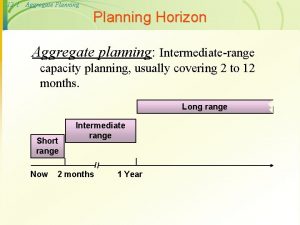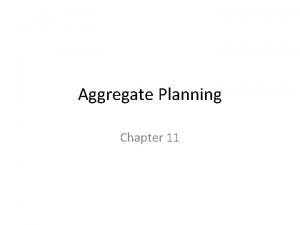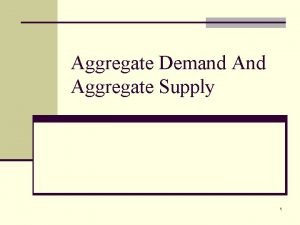Aggregate Planning Intermediaterange capacity planning Usually covers a














- Slides: 14


Aggregate Planning Intermediate-range capacity planning Usually covers a period of 12 months. Long range Short range Now Intermediate range 2 months 1 Year

Overview of Planning Levels • Long-range plans – Long term capacity – Location / Layout • Intermediate plans (Aggregate Planning) – Manpower Utilization regular time, overtime – Outsourcing Buying from a third party – Inventory carrying product for latter periods – Backlog satisfying the demand of the earlier periods – Hiring and layoff • Short-range plans (Scheduling) – Job assignments – Machine loading

Aggregate Planning Aggregate planning is a big picture approach to production planning. It is a production plan to meet the demand throughout the year. It is not concerned with individual products, but with a single aggregate product representing all products. For example, in a TV manufacturing plant, the aggregate planning does not go into all models and sizes. It only deals with a single representative aggregate TV. Such an aggregate TV may even does not exist in reality. All models are lumped together and represent a single product; hence the term aggregate planning.

Aggregate Planning Aggregate approach permits planners to develop intermediaterange capacity planning without being involved in too much details. In aggregate planning we are concerned with the quantity and also timing of demand. Demand is uneven through the year. Two basic characteristics of aggregate planning 1 -Aggregate Product 2 -Uneven Demand It begins with a forecast of aggregate demand for one year. Then a one year plan is prepared for each month. It includes volume of output, working hours, overtime, outsourcing, inventories, back orders, and hiring and layoffs.

Aggregate Planning 1 -Demand 2 -Regular time production 3 -Overtime production 4 -Outsourcing; buying from a third party 5 -Inventory; production in one period and sale in one or more later periods. 6 -Backlog; production in one period to satisfy the demand of one or more earlier periods. 7 -Hiring and layoffs A number of aggregate plans are examined in terms of feasibility and their costs. The best one is selected.

Aggregate Planning : Summary The question is how to produce to meet the demand. How many employees, how much overtime, outsourcing, inventories, back orders? Basic aggregate planning strategies are: Level Capacity Chase Demand Time period (year)

Level Capacity Maintaining a steady rate of output while meeting variations in demand by a combination of options Demand Production Time period (one year)

Cumulative output/demand Interesting Observation in Cumulative Graph Cumulative production Cumulative demand 1 2 3 4 5 6 7 8 9 10 11 12

Interesting Observation in Cumulative Graph Cumulative output/demand Give the following demand production. Using a line segment show the maximum inventory? Cumulative production Cumulative demand 1 2 3 4 5 6 7 8 9 10 11 12

Chase Demand Matching capacity to demand; production in each period is equal to the expected demand for that period. Demand Production Time period (year)

General Procedure for Aggregate Planning • Determine demand for each period. • Determine capacities (regular time, over time, subcontracting) for each period. • Identify company’s policies regarding inventories and work force. How much inventory is allowed? What rate of overtime and outsourcing is allowed? • Determine cost of working regular time and over time work, subcontracting, inventories, back orders. • Develop alternative plans, compare them and select.

Back order (backlog) Back order cost is the cost of satisfying the demand of one period in one or more periods later. It is the cost of loss of goodwill, potential discounts, backtracking, extra paperwork for transactions, etc. Back order cost is stated as cost / unit / period (the same as inventory cost). Total back order cost period is (cost / unit / period) × (total back order in the period).

Problem 1 Demand 1 2 190 230 3 260 4 280 5 210 6 170 7 160 8 260 9 180 Total 1940 There are 20 full time employees, each can produce 10 units period at the cost of $6 per unit. Therefore the supply of full time workers is as follows 1 2 3 4 5 6 7 8 9 Total 200 200 200 1800 Overtime cost is $13 per unit. Inventory carrying cost $5 per unit period Backlog cost $10 per unit period Maximum over time production is 20 units period Formulated the problem as a Linear Programming model. Using excel and solver find the optimal solution.
 Aggregate capacity planning
Aggregate capacity planning Examples of aggregate planning
Examples of aggregate planning Perencanaan kapasitas dan agregat
Perencanaan kapasitas dan agregat Ad curve graph
Ad curve graph Unit 3 aggregate demand aggregate supply and fiscal policy
Unit 3 aggregate demand aggregate supply and fiscal policy How to mix aggregate and non aggregate tableau
How to mix aggregate and non aggregate tableau Unit 3 aggregate demand and aggregate supply
Unit 3 aggregate demand and aggregate supply Shift in sras curve
Shift in sras curve Unit 3 aggregate demand aggregate supply and fiscal policy
Unit 3 aggregate demand aggregate supply and fiscal policy Production units have an optimal rate of output where:
Production units have an optimal rate of output where: Chase demand plan
Chase demand plan Level chase and hybrid strategies
Level chase and hybrid strategies Aggregate planning excel
Aggregate planning excel Aggregate planning and master scheduling
Aggregate planning and master scheduling Disaggregate planning
Disaggregate planning











